
Mid-June – we cross the border into Washington state – the state we didn’t really know much about then. It didn’t deserve our ignorance; one of it’s foremost merits are huge areas of woodland. What’s special about it is the vast rainforest nature reserve at Washington’s west coast – the Olympic National Park on the olympic peninsula. The peninsula lies at the USA’s nortwestern most spot and consists largely of the protected nature reserve. Even better – around 95% of the reserve has been designated as wilderness area, which provides a unique habitat for unique plant and animal species. It had been recommended to us to go there by the couple from Leipzig we had met at a campground near San Francisco. Since we didn’t have any plans yet for Washington back then, we just put the Olympic Park on our list. The second bullet-point became Seattle which several people in Oregon had described as a city worth visiting and last but not least there was Port Angeles, which should become our departure point for Canada.
We were beginning to feel that the remaing time for our journey started to run out for us so we more or less directly drove all the way through Washington up to the vicinity of Seattle, a metropolis with a fantastic setting at the sea near lots of small islands. At first we stayed a bit south of it in Tacoma since there was a Canping World store there where we wanted to claim the warranty for our unccoperative water heater. As soon as that was done we shifted our attention to Seattle. It’s easy to like the place but we had quite some trouble to find a place to spend the nights. We tried our luck at the parking lot of a botanical garden at first but around 11 pm we were shooed away by some rangers and had to relocate to a Home Depot parking lot. We ended up only spending a single day in Seattle but we rose early, took the Monorail into downtown and explored a few of the city’s highlights in warm weather and sunshine.
One of Seattle’s most famous sons is Bill Gates who tried to give some of his wealth to his hometown. Seattle appeared to us to be the richest and cleanest city we had visited so far and we spotted relatively few homeless and crazy people on the streets there. Everyone who might be interested in learning more about the Bill & Melinda Gates foundation can visit their museum for free. We gave it a try and spend about an hour with reading the information plaques that reported about some of the foundation’s projects from all around the world. The museum is very well done: there’s lots of opportunities to interact with the exhibits o the visitors are triggered to think about how the world could be shaped into a better place. You can project an own quote onto a wall, put new ideas on the ideas tree or construct models of innovations at a big table. The exhibits try to explain some of the biggest problems of our time and don’t shy away from controversial topics. The foundation propagates the use of genetic modifications to ensure richer harvests in poor countries but also explains that a lot of people are against and why that is. The visitors are invited to come to their own opinions and share them with others in a kind of virtual forum.
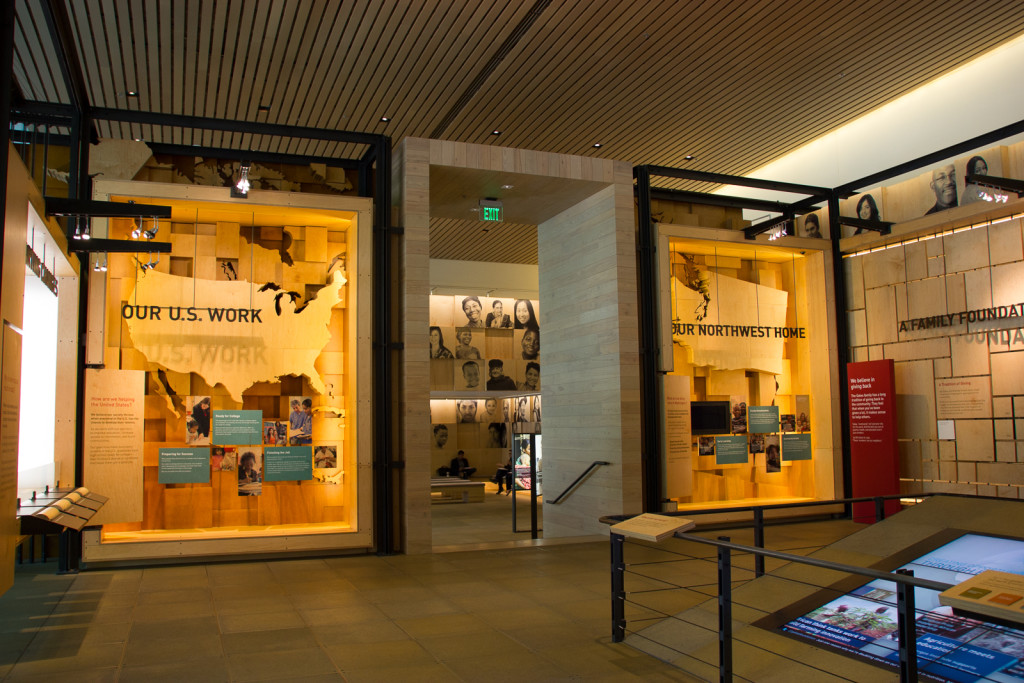

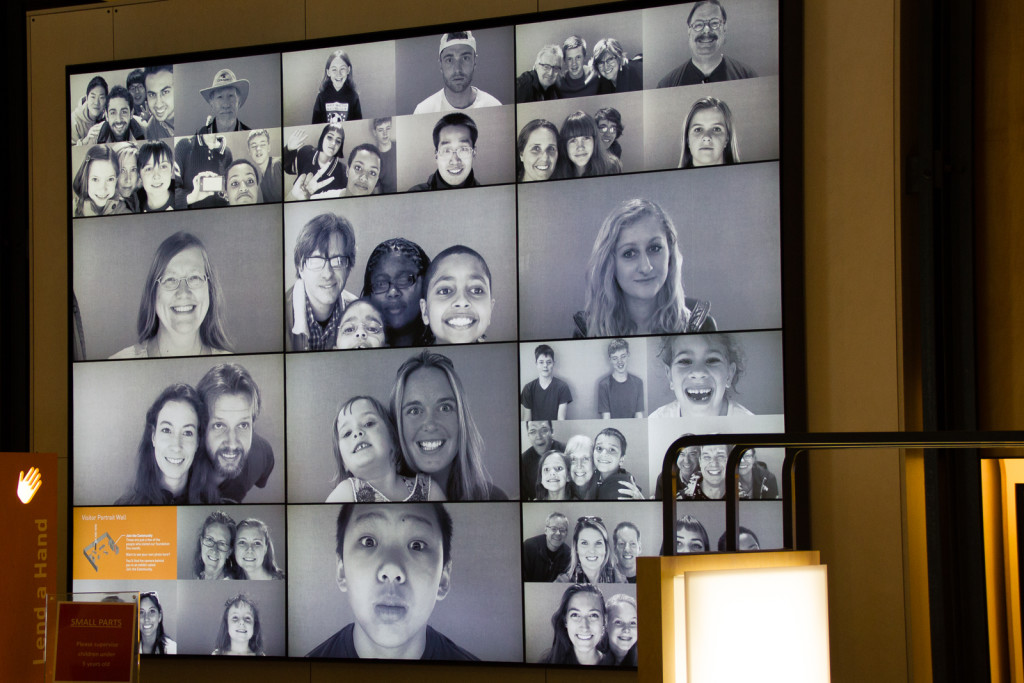
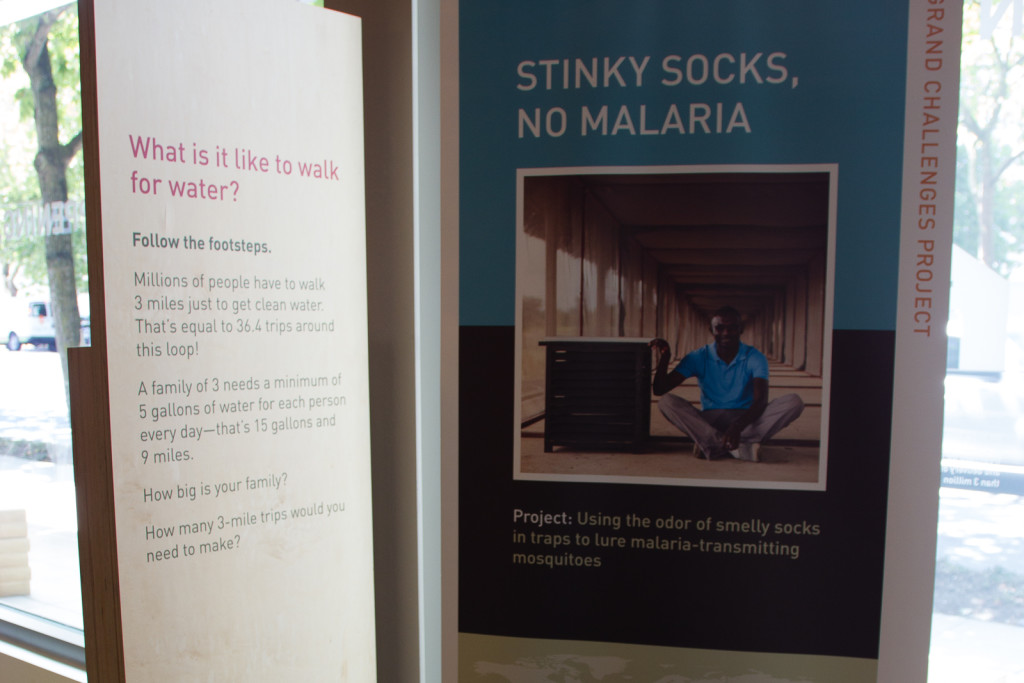
We skipped the part where one of the museums associates would have demonstrated the use of a stand-up pit toilet to us and rather continued our way to downtown Seattle.


We passed the Space Needle – Seattle’s most famous landmark. Directly beneath it lies the famous EMP museum of pop culture. There’s a connection to Micorsoft here too: the museum has been founded by Microsofts co-founder Paul Allen in 2000. The unusual and alluring building was desgined by star architect Frank Gehry. We had a peak into the museum’s lobby and gift shop but fled from the ticket price of more than 35 dollars per person.
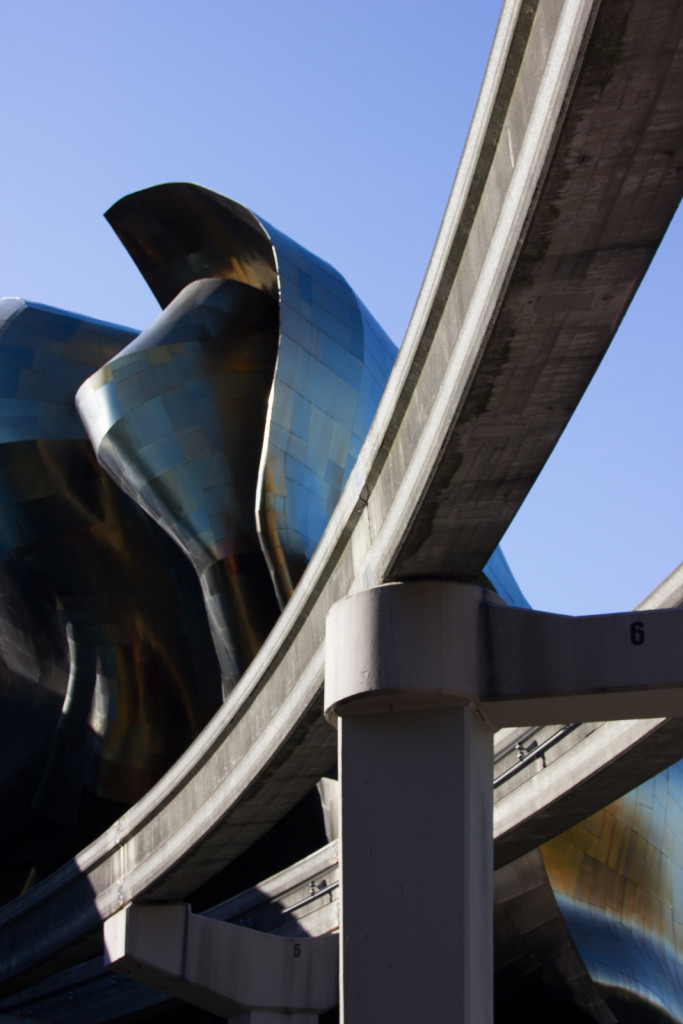
It’s easy to get around on foot in Seattle and do some sightseeing. Our last stop was the Pike Market, which is a multi-story building full of some unusual and cluttered second-hand clothing and book shops (with a very good selection), music stores selling vinyl records and some other eccentric stores. At the top there’s a big public market where you can listen to the fishmongers advertising the latest catch and you can find produce and snacks of all kinds.
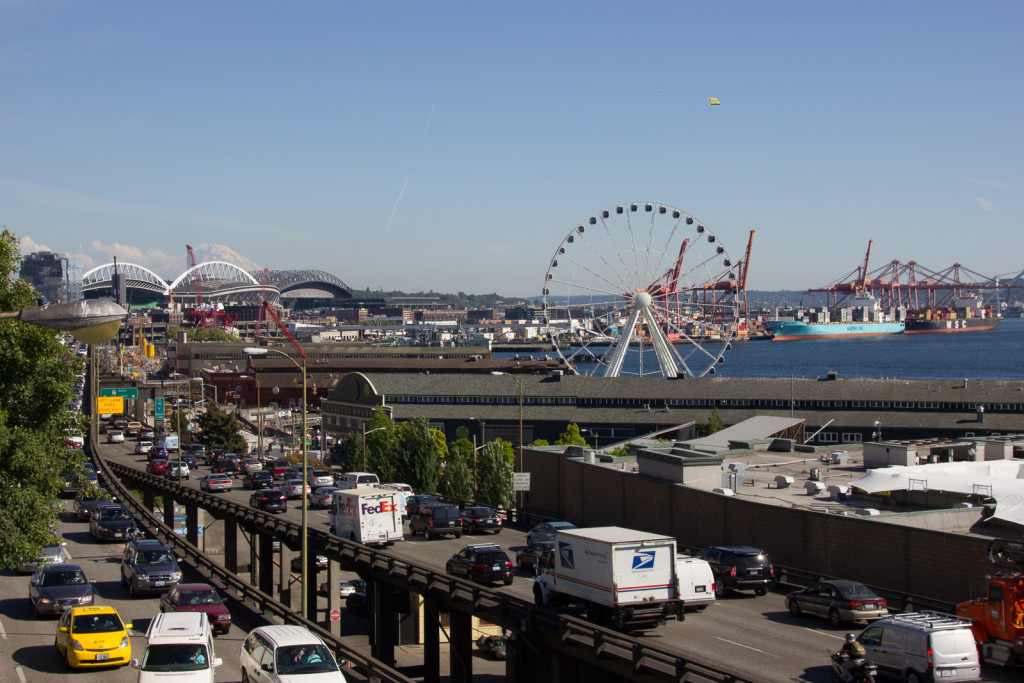
Just opposite the market building there is an attraction to be found that’s a bit odd: the world’s first Starbucks store. We read about it in our travel guide book. It is a bit strange though: Starbucks is the biggest food-chain right after Subway and really nothing else than a fast food store for coffee afficionados. Who knows – maybe the first Subway store somewhere makes people pose in front of it to take pictures too.

The next day we drove on to Port Angeles. We had something to pick up from the post office there: a privacy shelter for our outside shower, which is a kind of miniature tent. We had ordered it on the internet since the ones we had seen elsewhere were too expensive for our taste. Luckily it’s quite uncomlicated to have stuff delivered to some post office to care of general delivery and then go there to pick it up. We’re content with the model we bought and can now enjoy outside showers like back in El Zopilote. When we drove to Port Angeles we suddenly had a police car behind us that signaled us to stop with it’s flashing lights and siren. Luckily it turned out that the highway trooper was a very nice guy and had only stopped us because we had forgotten to clamp down the roof of our camper. While driving it had been lifted up all the time from the wind and some people going by had called the police so they could stop and tell us. The police as your friend and helper – who would have thought?

Shortly before Port Angeles there’s a very nice and remote campground in the woods at Dungeness Creek where we spent a night. In Port Angeles itself there’s a Walmart with a huge parking lot which we and some other campers took advantage of. While we stayed there we were able to determine when the ferry left for Vancouver Island and also paid a visit to the information center of the Olympic National Park to ask about hiking trails. We decided against a doing a multi-day hike in the end since you had to say exactly when and where you’d hike and camp in the backcountry and we wanted to be free in our decision with respect to the weather situation.
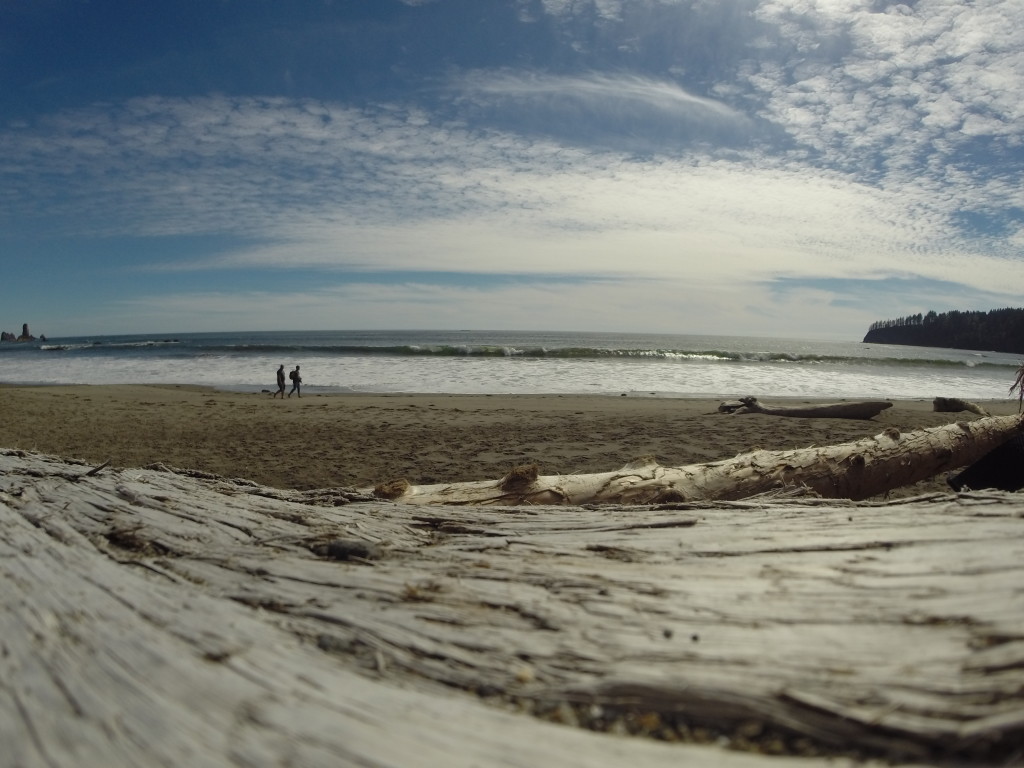
Before we got to Port Angeles I had read about the little town of Forks that has acquired some fame by appearing in Stephanie Meyer’s “Twilight” novels. Forks is situated at the northwestern corner of the Olympic peninsula, so it’s lying at the end of the world somehow, which was reason enough for us to go there and have a look. There’s also another really nice Forest Service campground there called Klahowya and the Hoh rain forest is very close to it.
Forks is rather unspectacular and more a village than a town but at the town border we spotted the first teenage girl posing in front of a road sign; the Twilight hype seems to be still going strong. There’s a long main street cutting through the whole town that offery nothing much than a small souvenir shop and a grocery store where all the food at the delicatessen counter has names related to the Twilight movies. Of course there’s some hidden highlights in that regard that make fans from all over the world go there when they’re in the area – the movie settings. There’s the Forks police station, the high school, Bella’s house and the most popular setting for taking a picture – two cars from the movies. I had downloaded a PDF file from the Forks tourism website where all the movie settings where marked on a map. Since Martin and I had seen the first three of the Twilight movies I lured him to Bella’s house. You’d turn from the main street into a residential area, which was sparsely populated and didn’t look that appealing. Then you’d take the second left, left again…..or something like that. We couldn’t find anything at first. Was it that house? Or the next one? No single house seemed to pop out from the rest. A black pickup truck slowly crawled through the area like we did, the father at the steering wheel, mom riding shotgun and in the back – of course – two teenage girls eagerly looking around. We spotted parents with their kids (mainly daughters) several times in Forks and always got the impression that they were badgered into going there. Eventually the pickup truck stops in front of a white house. There’s a sign at the front that says “for sale”. The windows are shuttered and the front lawn is uncared for. Apparently the owners got fed up with all the unwanted visitors and gave in. What’s really interesting about Forks is how such a remote and small place can become famous over night and still stay mostly the same as before: a humble, small town of logging workers and prison employees.
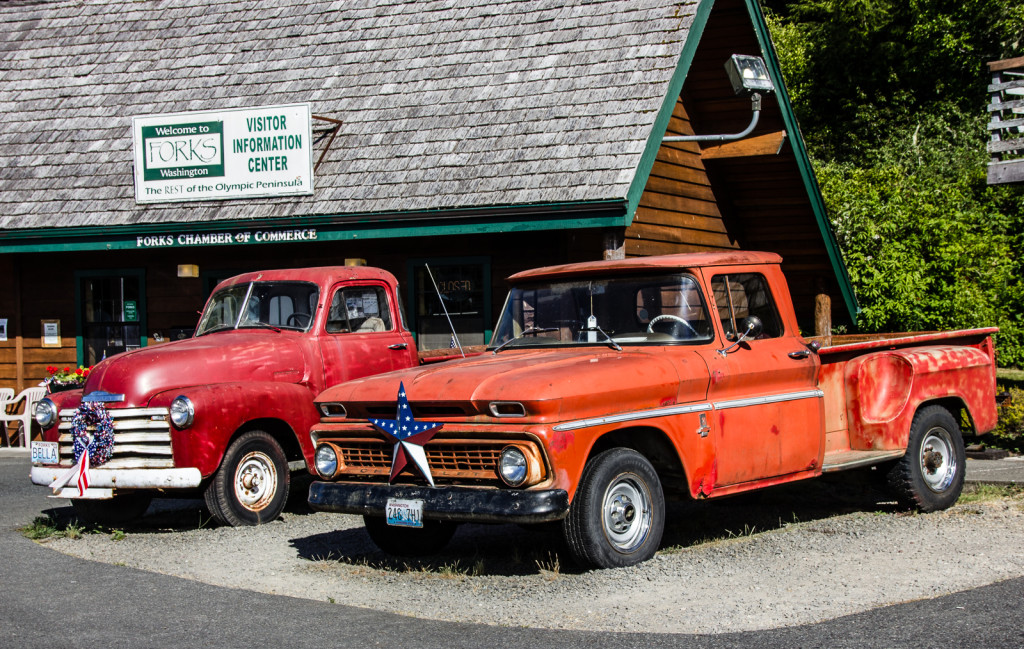
Our last stop in the area was supposed to be the Hoh rain forest, but when we drove there we discovered a really nice spot right at a river and decided to stay there for the night. The road leading to the rain forest visitor center is very scenic and goes right through the rain forest. Martin and I agreed that the Olympic National Park is a beautiful place but since we expected the landscape on Vancouver Island to be very similar and felt pressed for time we drove back to Port Angeles the next morning. I had read that it rarely gets above 20° Celcius on Vancouver Island we made a stop at an outdoor shop right t the edge of the rain forest. I thought we needed to get some warmer clothing and purchased a good quality rain jacket. The grass-green jacket was the last one of that model and the owner of the store was so happy that finally somebody was interested in the XS size jacket that she offered a 30% discount right away. Martin got a nice hat for hiking and later also found a warm jacket in a thrift shop in Port Angeles.
In front of the outdoor outfitters we noticed a guy that stuck out like a sore thumb. As mentioned earlier…the rain forest on the Olympic peninsula is a habitat for some unique species. In this case the specimen was an older guy with long white hair wearing simple leather garments of stone age style and gaiters over bare feet. We kept seeing the guy’s face on some ads that said that Mick Dodge would be here or there, apparently to answer questions by everybody who wanted to talk to him. A quick internet research told us that we had spotted Mick Dodge, a rather unique fellow who’s been running around barefoot in the woods for the past 20 years and also has his very own reality TV show on the National Geographic channel.
Back in Port Angeles we stayed at the Walmart parking lot for another night and took an early ferry to Victoria on Vancouver Island the next day. We would have liked to see the 4. of July (Independence Day) festivities before we left the USA but Canada is a very big and wonderful country too and our journey had to go on. The ferry only took 90 minutes to get to Canada and behind us the Olympic Mountains disappeared in the sea fog while a new country appeared in front of us. Where not gone for good from the United States though, since we’ll be returning there in August to hopefully sell our car and camper and take the plane back home from New York.
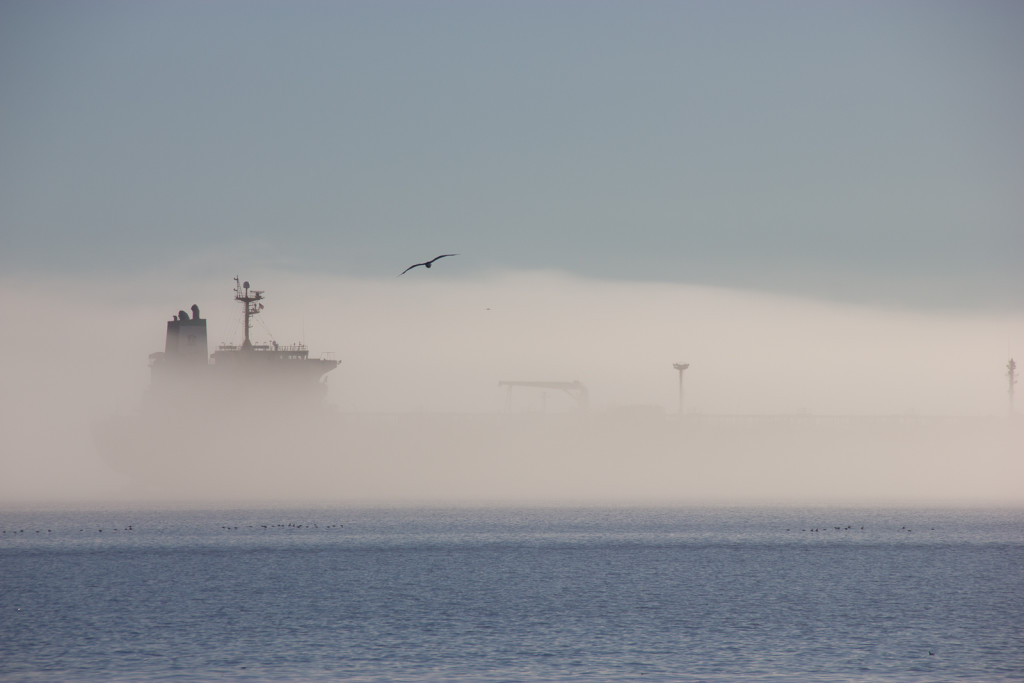
German version – deutsche Version
Mitte Juni – wir überqueren die Grenze zu Washington State, dem Staat, von dem wir bisher – zu Unrecht – am wenigsten wussten. Washington besticht wie Oregon durch große, dichte Wälder. Das Besondere: An der Westküste von Washington gibt es eine große geschützte Fläche von gemäßigtem Regenwald und zwar im Olympic National Park auf der olympischen Halbinsel. Dieser westlichste Zipfel der USA besteht zum Großteil aus Naturschutzgebiet und ganze 95% davon sind auch noch als Wilderness deklariert, ein einzigartiger Lebensraum für einzigartige Pflanzen und Tiere! Diesen Tipp bekamen wir übrigens von den beiden Leipzigern, die wir auf dem Campingplatz bei San Francisco getroffen hatten und da wir zu dem Zeitpunkt keinerlei Vorstellungen von Washington hatten, setzten wir den Ort auf unsere Liste. Dazu kam noch Seattle, das uns in Oregon mehrfach als sehenswerte Stadt empfohlen wurde, und Port Angeles als Einfallstor nach Kanada.
Da wir langsam das Gefühl hatten nicht mehr allzu viel Zeit von unserer Reise übrig zu haben, fuhren wir schnurstracks durch den Großteil von Washington hindurch bis fast nach Seattle, einer fantastisch gelegenen Metropole umrahmt von vielen kleinen Inseln. Wir blieben zunächst etwas unterhalb davon in Tacoma, denn dort gab es eine Filiale von Camping World, wo wir unseren Garantieanspruch bezüglich des eigenwilligen Wasserboilers in Anspruch nahmen. Sobald das erledigt war, kam Seattle an die Reihe. In dieser Stadt kann man es gut aushalten, doch wir hatten Probleme einen Übernachtungsplatz zu finden. Wir versuchten erst auf dem Parkplatz eines botanischen Gartens etwas außerhalb der Stadt unsere Nachtruhe zu finden, wurde dann aber gegen 23 Uhr von den Gärtnern vertrieben und mussten mit einem Baumarkt-Parkplatz Vorlieb nehmen. So kam es, dass wir nur einen einzigen Tag in Seattle verbrachten, doch wir standen früh auf, nahmen die Monorail in die Innenstadt und erkundeten ein paar Highlights bei strahlendem Sonnenschein.
Einer der bekanntesten Söhne der Stadt dürfte Bill Gates sein, der auch einiges an Geld in seine Heimatstadt gesteckt hat. Seattle macht verglichen mit allen anderen Großstädten, die wir bisher in den USA besucht haben, den reichsten Eindruck und es sind nur wenige Bettler und Verrückte zu sehen. Wer sich für Bill Gates und die Bill & Melinda Gates Stiftung interessiert, bekommt kostenlosen Eintritt in deren Museum gewährt. Wir machten den Versuch und verbrachten eine knappe Stunde damit diverse Infotafeln zu lesen, die über Projekte der Stiftung rund um die Welt berichten. Das Museum ist gut aufgemacht: Es gibt viele Möglichkeiten zur Interaktion mit dem Ziel, den Besucher dazu zu bewegen, sich selbst zu überlegen wie man die Welt zu einem besseren Ort machen kann. Eigene Meinungen können an eine Wand projiziert werden, neue Ideen für Weltverbesserungen kommen an den Ideenbaum und an einem großen Tisch werden Modelle für neue Innovationen gebastelt. Das Museum klärt über viele große Probleme unserer Zeit auf und macht auch vor kontroversen Themen keinen Halt. So unterstützt die Stiftung Gentechnik, mit dem Ziel die Erträge von Bauern in armen Ländern zu mehren und räumt ein, dass es hierzu viel Gegenwind gibt. Der Besucher ist dazu eingeladen, seine eigene Meinung in einer Art vituellem Forum mit anderen zu teilen.
Am Ende unseren Besuches verzichteten wir darauf, uns die Verwendung eines Steh-Plumpsklos von einem Museumsmitarbeiter demonstrieren zu lassen und schlenderten weiter Richtung Stadtzentrum.
Wir kamen an der Space Needle vorbei, dem Wahrzeichen von Seattle. Direkt daneben befindet sich das berühmte EMP Museum für Popkultur. Auch hier gibt es eine Verbindung zu Microsoft: Das Museum wurde im Jahr 2000 von Microsoft Co-Gründer Paul Allen gegründet. Das Gebäude wurde von Star-Architekt Frank Gehry entworfen, ein echter Hingucker. Wir linsten kurz in die Museumslobby, nur um vor dem horrenden Eintrittspreis in Höhe von 35 Dollar pro Person zu fliehen.
Die bekanntesten Sehenswürdigkeiten der Stadt lassen sich gut per pedes abklappern. Unser letzter Stopp sollte der Pike-Market sein, ein mehrstöckiger überdachter Markt, der einige seltsam-schrullige Second-Hand-Läden, vollgestopfte, muffige Buchläden (aber mit grandioser Auswahl), Plattenläden, Kuriositäten-Shops und vieles mehr bietet. Ganz oben gibt es dann noch die Markthalle, wo Fischverkäufer ihren besten Fang des Tages anpreisen und frische Snacks aller Art verzehrt werden können.
Gegenüber der Markthalle befindet sich eine etwas seltsame “Sehenwürdigkeit”: der erste Starbucks. Wir erfuhren über unseren Reiseführer davon. Es ist schon kurios: Starbucks ist nach Subway die größte Kette und ist eigentlich nichts anderes als ein Fast-Food-Lokal für Kaffeetrinker. Doch wer weiß, vermutlich treibt auch irgendwo der erste Subway die Leute dazu, vor dem Eingang zu posieren und Fotos zu schießen.
Am nächsten Tag fuhren wir weiter Richtung Port Angeles. Dort wollten wir auch noch ein ganz besonderes Utensil bei der Post abholen: Unseren Privacy-Shelter, eine Art Zelt, das man als Duschkabine verwenden kann. Wir hatten dieses Exemplar im Internet bestellt, da wir bei Campingworld und Konsorten nie fündig geworden waren. Zum Glück ist es meist unkompliziert, sich Sachen als “general delivery” an eine Poststelle senden zu lassen. Mit unserem Modell sind wir bisher sehr zufrieden und genießen unsere japanischen Duschen wie annodazumal in El Zopilote.
Auf dem Weg dorthin haben wir auf einmal die Polizei hinter uns, die uns mit Blaulicht und Sirene zum Anhalten bewegen will. Wie sich herausstellte, war der Highway Trooper aber nicht nur sehr nett, sondern hat uns auch nur gestoppt weil wir vergessen hatten das Dach unseres Campers zu fixieren. So wurde es vom Fahrtwind immer wieder hochgedrückt und mehrere Leute hatten die Polizei angerufen, damit man uns anhält und Bescheid sagt. Die Polizei – dein Freund und Helfer; wer hätte das für möglich gehalten?
Kurz vor Port Angeles verbrachten wir noch eine Nacht auf dem idyllischen und abgelegenen Dungeness Creek Campground im Wald. In Port Angeles residiert zu des Campers Zufriedenheit ein Walmart mit riesigem Parkplatz. Wir nächtigten dort und erkundigten uns über die Abfahrtszeiten der Fähre nach Vancouver Island und fuhren zum Visitor Center des Olympic National Park, um nach Wanderrouten zu fragen. Eine längere Wanderung ergab sich schlussendlich nicht für uns, da man genau angeben musste, wo und wie lange man laufen möchte (wenn man im Hinterland campen will) und wir wollten uns die Freiheit lassen, nach Wetterlage zu entscheiden.
Bevor wir nach Port Angeles gekommen waren hatte ich über das kleine Örtchen Forks gelesen, was seit Stephanie Meyers Roman “Twilight” zu plötzlichem Ruhm gelangte. Forks liegt am nordwestlichen Ende der olympischen Halbinsel und somit irgendwie am Ende der Welt, Grund genug, ihm einen Besuch abzustatten. Außerdem fanden wir dort in der Nähe einen schönen State Park Campground Klahowya und ein Stück weiter südlich erstreckt sich der Hoh-Regenwald, ein besonders feuchtes Terrain mit viel Farn und Moosen.
Forks selbst ist absolut unscheinbar und scheint mehr Dorf als Stadt, doch schon am Ortseingangsschild erblickten wir das erste posierende Mädchen: Der Twilight-Wahnsinn hält noch an. Eine lange Hauptstraße führt durch den verschlafenen Ort, der Touristen nicht viel zu bieten hat, außer vielleicht den kleinen Souvenirladen rechter Hand oder den Supermarkt, der an der Frischetheke sämtlichen Lebensmitteln einen Twilight-bezogenen Namen gibt. Natürlich gibt es da auch noch die versteckten Highlights, für die Fans aus aller Welt anreisen: Filmkulissen. Da wäre die Forks Polizeistation, die Highschool, Bellas Haus und das beliebteste Fotomotiv, zwei Autos aus dem Film. Ich hatte mir von der Forks-Website ein PDF runtergeladen, wo sämtliche Filmkulissen der Stadt verzeichnet sind. Da wir die ersten drei Filme der Twilight-Reihe gesehen hatten, köderte ich Martin Richtung Bellas Haus. Man bog von der Hauptstraße ins Wohngebiet ab, ein dünn besiedeltes, weitläufiges und eher unattraktives Areal. Die zweite links, dann noch mal links … oder so. Wir fanden nichts. War es das? Oder das da? Kein Haus schien herauszustechen. Ein schwarzer Pickup schlich ebenso verdächtig durch die Blocks, der Vater am Steuer, die Mutter daneben und hinten, wie könnte es anders sein, die zwei Töchter, mit vorgestreckten Köpfen. Immer wieder sehen wir hier Eltern, die offensichtlich von ihren Töchtern gezwungen wurden nach Forks zu fahren. Schließlich kommt der Pickup vor einem weißen Holzhaus zum stehen. Davor ein Schild: FOR SALE. Die Fenster sind verriegelt, der kleine Vorgarten ungepflegt. Offensichtlich hatten die Hausbesitzer irgendwann die Faxen dicke und wollten ihr Leben in Ruhe fortsetzen. Das ist das eigentlich interessante an Forks: Wie ein so abgeschiedener Ort ohne jegliches Zutun zu beispiellosem Ruhm gelangen kann und doch nicht aufhört so zu sein, wie er immer schon war: Ein einfacher, bescheidener Ort von Waldarbeitern und Gefängnis-Angestellten.
Unsere letzte Station sollte der Hoh-Regenwald sein, wir blieben jedoch schon früher an einem tollen Stellplatz direkt am Fluss hängen und ließen uns die Sonne auf den Bauch scheinen. Die Fahrstrecke Richtung Hoh Rain Forest Visitor Center ist traumhaft, eben direkt durch den Regenwald. Wir waren uns einig, dass der Olympic National Park ein Juwel ist, doch wir erwarteten eine ähnliche Landschaft auf Vancouver Island und da wir langsam einen Zeitdruck verspürten, fuhren wir gleich am nächsten Morgen zurück Richtung Port Angeles. Da ich gelesen hatte, dass Vancouver Island selten Temperaturen über 21 Grad Celsius aufweist, legten wir noch einen kurzen Stopp bei einem Outdoor-Laden mitten in der Einöde des Rainforest ein. Ich dachte wir wären genötigt, unsere Garderobe um eine paar wärmere Teile aufzustocken und so kaufte ich mir eine windabweisende Regenjacke. Das grasgrüne Exemplar hing einsam an der Stange und als ich die Jacke anprobierte, war die Verkäuferin so froh darüber, dass endlich jemand in dieses kleine Model reinpasste, dass sie mir 30% Rabatt anbot. Martin fand einen schönen Hut mit breiter Krempe und später in einem Thrift Shop in Port Angeles eine billige gefütterte Jacke von Nike. Vor dem Outdoor-Laden fiel uns noch eine Person auf, die so ganz und gar nicht wie der übliche Zeitgenosse aussah. Wie eingangs schon erwähnt… der Regenwald auf der olympischen Halbinsel ist Lebensraum für viele einzigartige Lebewesen. In diesem Fall ein alter Mann mit langen weißen Haaren, einfachen Lederklamotten, die ein bißchen nach Steinzeit aussehen und großen Gamaschen über nackten Füßen. Das Gesicht des Mannes sahen wir immer mal wieder auf Aushängen, wo es hieß Mick Dodge sei im Ort, offensichtlich um Fragen der Bevölkerung zu beantworten. Eine kurze Internetrecherche ergab dann, dass es sich bei Mick Dodge um einen schrulligen Waldmenschen handelt, der seit über zwanzig Jahren barfuß läuft, im Wald lebt und ganz nebenbei auch noch eine eigene Reality Show im National Geographic Fernsehsender bedient.
Zurück in Port Angeles verbrachten wir noch eine weitere Nacht bei Walmart um am nächsten Morgen mit einer frühen Fähre nach Victoria auf Vancouver Island überzusetzen. Wir hätten gerne noch den 4. Juli, den Nationalfeiertag der Amerikaner, abgewartet, doch auch Kanada ist ein großes wunderbares Land und es muss weitergehen. Die Fahrt auf der Fähre dauerte nur 90 Minuten, hinter uns verschwanden die Olympic Mountains im Nebel, vor uns tat sich neues Land auf. Es ist kein Nimmerwiedersehen, im August werden wir wieder amerikanischen Boden betreten, unser Auto verkaufen und den Flieger von New York zurück nach Deutschland nehmen.
